Introduction
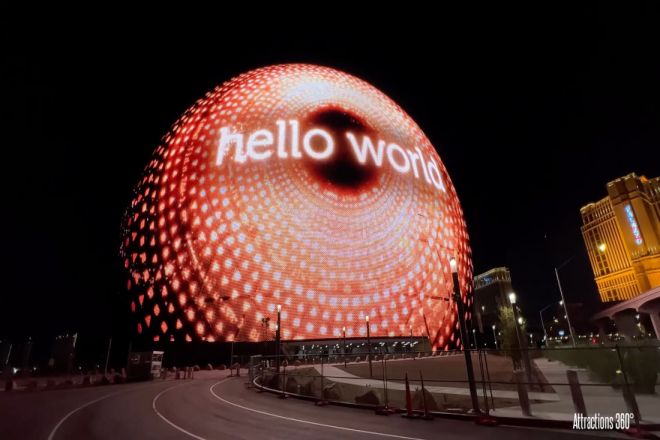
Have you seen the spherical LED display in Las Vegas on social networks? It is by far the largest spherical LED display in the world.
In fact, we can also see many spherical LED displays in daily life, and their sizes are different. Do you know anything about this creative LED display? Read the article below, and let’s explore the spherical LED display together.
1. Types of spherical LED displays
According to the structure and shape of LED screens, they can also be divided into the following types:
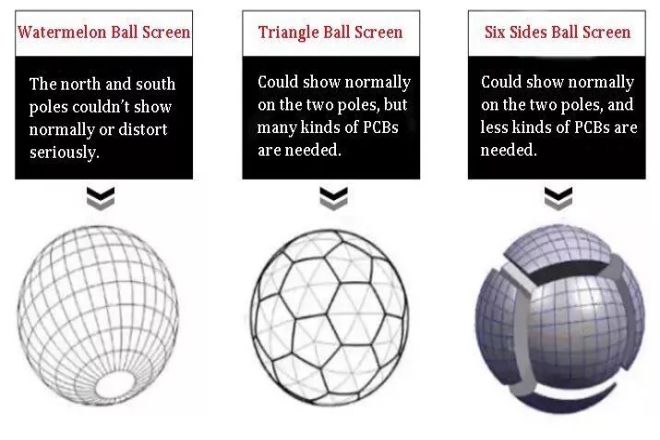
- Watermelon peel LED spherical screen
Imagine you are cutting a watermelon, and each slice is curved, a bit like an orange segment. Now, put these “watermelon rind” shaped circuit boards together to form a ball. This is the basic structure of the watermelon peel LED spherical screen.
The advantage of this screen is that its structure is simple and easy to understand. However, because the “watermelon rind” is curved, the screen cannot display images well at the top and bottom of the ball, which are what we usually call the “North Pole” and “South Pole” positions. It’s like trying to peel a watermelon evenly on the top and bottom. This results in low image utilization of the entire screen.
- Triangular LED spherical screen
Now let’s look at a football. A soccer ball is made up of many small pieces, each of which is triangular. If these triangular circuit boards are put together, they can also form a ball. This is a football-shaped LED spherical screen.
This screen solves the problem of poor display at the top and bottom of the watermelon screen because it uses small triangles to fill these gaps. Therefore, the usage rate of the screen has been greatly improved. However, because triangles come in so many different shapes and sizes, making such a screen would require many different types of circuit boards, and the programming would be more complicated.
- Six-sided LED spherical screen
Finally, let’s imagine a Rubik’s Cube. The Rubik’s Cube has six sides, each of which is a square. If we replace each side of the Rubik’s Cube with an LED display and then bend these sides into a ball, we will get a six-sided LED spherical screen.
The advantage of this screen is that its pixels are evenly distributed and look as clear as an ordinary flat LED display. And, because it’s made up of six identical sides, it’s relatively simple to make. Each side is composed of four small boxes. Each small box contains 16 circuit boards with LED lights soldered on them. Finally, these small boxes are assembled together to form a complete spherical screen.
2. The principle of spherical LED display
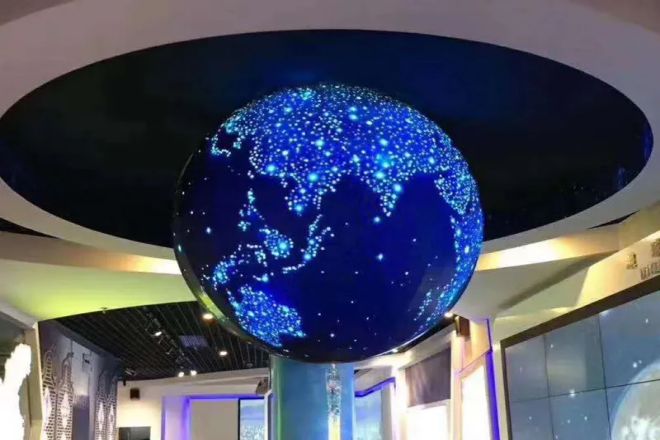
The principle of the spherical LED display is mainly based on the self-luminous display technology of LED (light-emitting diode). The LED display screen displays different images and video content by controlling the lighting and color changes of the LED lamp beads.
For spherical LED displays, due to their special spherical structure, the plane image source needs to be mapped onto the three-dimensional spherical surface after special processing. This usually involves splitting the original image into multiple parts and deforming and mapping them according to the geometry of the spherical surface to ensure that the image is displayed correctly on the spherical screen.
In a spherical LED display, multiple LED modules or unit boards are usually used to splice the entire spherical surface. Each LED module or unit board contains a certain number of LED lamp beads, which can be independently controlled by the control system to achieve a full-screen display effect.
The control system of the spherical LED display is the core part of the entire system. It is responsible for receiving image source signals, performing image processing and mapping, and sending the processed signals to each LED module or unit board. The control system also needs to synchronously control each LED module or unit board to ensure that the image on the entire spherical screen can be displayed smoothly.
In addition to displaying image and video content, the spherical LED display can also achieve some special effects, such as dynamic gradients, text scrolling, etc. These effects can be achieved through programming and control systems, bringing a richer visual experience to the audience.
3. The difference between spherical LED display and traditional LED display
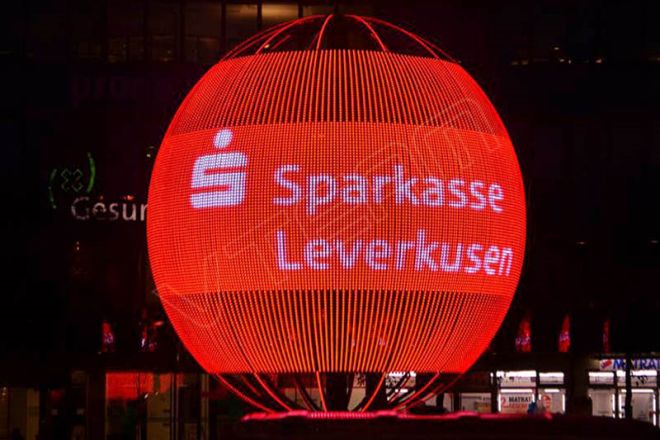
1). Shape and Design
Traditional LED display: usually flat, with a fixed rectangular or square shape. This design makes them suitable for many common applications such as supermarkets, bus stops, retail stores, etc.
Spherical LED display: breaks the traditional plane restrictions and presents a three-dimensional spherical structure. This design not only attracts people’s attention but also provides a wider viewing angle and a more immersive experience.
2). Display range and angle
Traditional LED display: Due to its flat structure, viewers must stand at a specific angle to see the complete image. If the viewer stands at the edge of the screen, part of the image or content may be missed.
Spherical LED display: Due to its spherical design, viewers can see the complete image no matter where they stand. This all-round display enables every viewer to get the best viewing experience.
3). Production difficulty and cost
Traditional LED displays: Although production technology is also constantly improving, their manufacturing and installation processes are relatively simple. Therefore, the cost is relatively low and suitable for a wide range of applications.
Spherical LED display: Making a spherical LED display requires a more complex design, more advanced manufacturing technology, and a more delicate installation process. Additionally, due to their customization and uniqueness, the cost is usually higher. This makes them more suitable for specific, high-end applications.
4). Application areas and flexibility
Traditional LED display: Due to its universality and applicability, it is widely used in various occasions, such as advertising, sports, entertainment, etc. They can be found in both commercial and domestic settings.
Spherical LED display: Due to its unique shape and display effect, it is more suitable for specific, innovative, and high-end applications. For example, planetariums, art exhibitions, high-end commercial displays, etc. These occasions usually require a unique visual experience to attract the audience, and spherical LED displays just meet this need.
4. Advantages of spherical LED display
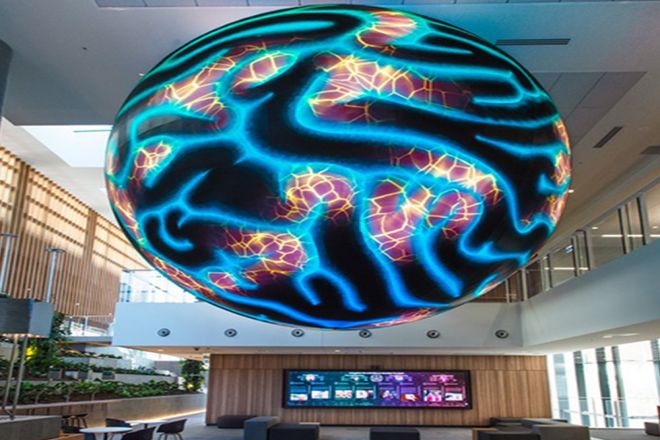
- Comprehensive visual effects:
The spherical LED display can provide a 360-degree all-round display effect. No matter which angle the audience stands, they can get clear and realistic images and video content. This all-round display brings a more immersive visual experience to the audience.
Imagine you’re standing at the center of a sphere, and you see a clear image no matter which direction you look. This is the charm of a spherical LED display. It can give you an immersive feeling like you are in an all-around visual feast.
- Greater flexibility:
Spherical LED displays can be customized according to different occasions and needs. No matter how big a screen, how high a resolution, or how bright you need, you can adjust it to your specific needs. This flexibility allows it to adapt to a variety of environments and uses.
- Perfect splicing:
When you put multiple screens together, there are often gaps or color inconsistencies. However, the spherical LED display uses special splicing technology to connect the screens perfectly and look like a complete sphere. This seamless splicing technology makes the display effect even better.
- Lamp beads cost less:
Although the spherical LED display screen looks high-tech, its cost is actually not high. By using uniform spot sampling technology, the number of LED lamp beads can be reduced while ensuring the display effect, thereby reducing manufacturing costs. This means you can enjoy a more affordable price without sacrificing display performance.
- Energy saving:
LED lamp beads are a very energy-saving light source. Compared with traditional display technology, they consume less energy and have a longer service life. Moreover, LED lamp beads do not contain harmful substances and are more environmentally friendly. This means that the use of spherical LED displays can not only bring excellent visual effects but also contribute to the earth’s environmental protection.
- Wide range of application scenarios:
Spherical LED displays can be used on various occasions, such as museums, planetariums, sports venues, etc. Whether displaying artwork, playing astronomy videos, or presenting sports matches, it delivers outstanding visuals. At the same time, due to its unique appearance and display effect, it has also become an ideal choice for various activities and performances.
5. Market prospects and challenges of spherical LED displays
1). Market expectation
- Demand growth
LED displays are gradually becoming commonplace. For example, if you walk on a busy street, you can almost see many LED displays playing advertisements, so people have begun to feel visual fatigue when faced with this conventional LED display.
The innovative LED display screen has undoubtedly a very strong impact and attraction on people’s vision, so the market for spherical LED display screens has opened up. This is undoubtedly a rare opportunity for spherical LED displays.
- technological innovation
As the new star of LED display technology, spherical LED display screens still have a lot of room for technological innovation.
With the continuous breakthroughs in LED chip technology, the display effect of spherical LED displays will be more realistic and delicate, and the color reproduction will be higher. At the same time, with the development of intelligence, the Internet of Things, and other technologies, intelligent management and remote control of spherical LED displays will also become possible.
These technological innovations will inject new impetus into the development of spherical LED displays and promote their application in more fields.
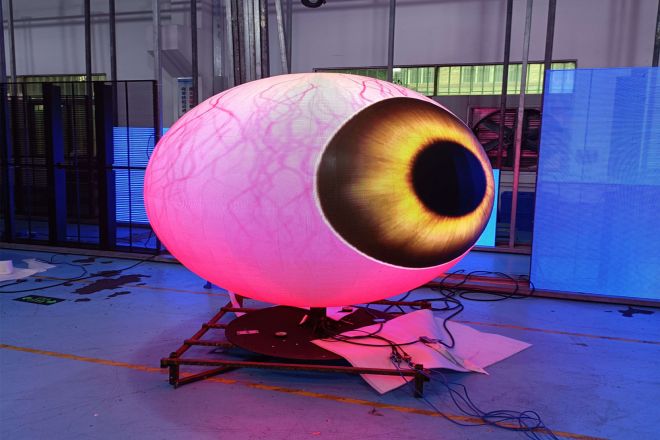
2). Market challenges
- Cost issue
At present, the manufacturing cost of spherical LED displays is relatively high, mainly because of its unique structural design and complex production process. At the same time, marketing and brand building also require substantial capital investment.
This makes the price of spherical LED displays relatively high, limiting its application in some mid- to low-end markets. Reducing costs and improving the performance-price ratio are important challenges facing spherical LED displays.
- Technical bottleneck
Although spherical LED displays have made great technological breakthroughs, they still face technical bottlenecks in some aspects. For example, how to further improve display effects, reduce energy consumption, and improve stability still requires further research development and innovation.
In addition, the installation and maintenance of spherical LED displays are relatively complex and require professional technicians to operate. These technical difficulties limit the application and promotion of spherical LED displays in certain fields.
- Market competition
As the spherical LED display market continues to develop, competition is becoming increasingly fierce. Many domestic and foreign companies are actively exploring this market and launching unique products. In such a competitive environment, how to stand out and gain market share is a question that spherical LED display companies need to think about.
At the same time, with the saturation of the market and the diversification of consumer demands, continuing to innovate and meet the diversified needs of the market is also a challenge that spherical LED display companies need to face.
6. How do you choose a spherical LED display that suits you?
First, determine the size, dimensions, purpose, and location of the spherical LED display you need. After knowing these, you can find a suitable LED display supplier and let them give you a solution that suits you.
If you trust us, you can also contact us directly. We will send the most professional personnel to communicate with you.
Conclusion
The spherical LED display screen is leading a new chapter of the visual feast with its unique charm and unlimited possibilities. With its all-round display effect and immersive experience, it provides the audience with unprecedented visual enjoyment. I believe that with the advancement of technology, its development will be even greater!
The above is all the knowledge about spherical LED displays. If you want to receive more, please get in touch with us!
